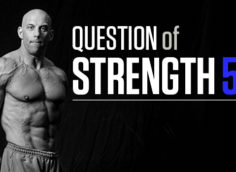The Jefferson deadlift – also known simply as the Jefferson lift – is a classic strongman movement that for whatever reason has gone the way of the 8 track cassette and hair metal. That's a low-down dirty shame because the Jefferson deadlift is great for strength, power, core stability, and hip durability. It should be a staple in any serious strength athlete's routine.
The movement is a great way to encourage people to get their knees open so they can take a wider stance in their squats while building some rotational range of motion. It also coaxes them outside of a pure saggital plane movement pattern that can become dominant if not addressed.
Dave Dellanave holds the world record in the Jefferson deadlift and it's one of the main lifts he prescribes to trainees. Here's Dave setting the world record for a 605-pound Jefferson lift at a bodyweight of 202 pounds:
The Jefferson deadlift is really useful because it hits a lot of training areas, some of which are sorely missing in most lifters' movement habits. "You get asymmetry, rotation, hip hinging, and heavy loading all in one movement," says Dave. "The asymmetrical position seems to be especially helpful for people who struggle with pain or movement issues in more traditional or symmetrical deadlifts.
"The lift also tends to be self-correcting in that there's no one ideal way to do it, so people are free to find the best leverage that works for their body, provided they're not doing something egregiously dangerous and outside their limits. Interestingly, I've seen a not-insignificant number of people for whom doing only one side of the Jefferson works out better."
The biomechanics of the lift are straightforward. Your center of gravity is vertical over the load and your feet straddle the bar to provide a large base of support through which to generate force.
In a conventional deadlift, you have the majority of the weight behind the bar, thus the base of support is relatively small compared to the Jefferson. The sumo stance has a wider base, but again the majority of weight is behind the bar at set up, which means leaning and increasing shear forces on the low back.
If you use a Jefferson stance, though, you can increase the vertical position of the spine and thus allow more compressive forces and fewer shear forces, making it an easier exercise for guys with jacked-up low backs.
If you want to increase the amount of weight you lift, having your center of gravity vertical over the load along with a larger base of support equates to better leverage, and that translates to bigger lifts. I tried it out yesterday, cold and still in my work uniform, just to see what would happen with heavier loading.
I started with 225 and then did 315, each for 3 reps, using a double-overhand grip. I did one rep at 405, but my grip failed when I got to about mid-thigh. I switched to a mixed-grip and 405 felt pretty easy, considering my lifetime max for a conventional pull is 455. As far as my effort, I'd say I hit about a 7 out of 10.
I'm sure I could do some serious weight, given that there was no strain on my low back and it felt relatively strong. Maybe 500 pounds isn't far off?
The cool thing about a Jefferson deadlift is everyone will have a slightly different way of approaching it. The basics are as follows:
- Straddle the bar
- Grab the bar
- Stand up with the bar
More specifically:
- Make sure your spine remains relatively linear so you aren't rounding or seriously deviating away from a neutral position.
- When you start pulling, make sure your knees don't collapse towards the midline in a valgus party you sure don't want to be invited to.
- Don't lock out your knees before your hips get through the movement; otherwise you'll be doing a really awkward good morning with nothing but your hips.
- Take a grip that's vertical under your shoulders and not wider.
Above all, play with it. Try the Jefferson deadlift with the left leg forward, the right leg forward, different grips, and see what works best for you.
Work with higher reps, lower reps, heavy weight, lighter weight, and everything in between to achieve the full benefits. The Jefferson deadlift allows for many small alterations that will introduce significant variety to your workouts.





